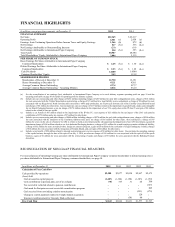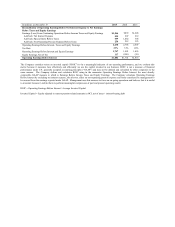International Paper 2015 Annual Report Download - page 20
Download and view the complete annual report
Please find page 20 of the 2015 International Paper annual report below. You can navigate through the pages in the report by either clicking on the pages listed below, or by using the keyword search tool below to find specific information within the annual report.3
RESEARCH AND DEVELOPMENT
The Company operates its primary research and
development center in Loveland, Ohio, as well as
several product laboratories. Additionally, the Company
has an interest in ArborGen, Inc., a joint venture with
certain other forest products companies.
We direct research and development activities to short-
term, long-term and technical assistance needs of
customers and operating divisions, and to process,
equipment and product innovations. Activities include
product development within the operating divisions;
studies on innovation and improvement of pulping,
bleaching, chemical recovery, papermaking, converting
and coating processes; packaging design and materials
development; mechanical packaging systems,
environmentally sensitive printing inks and reduction of
environmental discharges; re-use of raw materials in
manufacturing processes; recycling of consumer and
packaging paper products; energy conservation;
applications of computer controls to manufacturing
operations; innovations and improvement of products;
and development of various new products. Our
development efforts specifically address product safety
as well as the minimization of solid waste. The cost to
the Company of its research and development
operations was $27 million in 2015, $16 million in 2014
and $18 million in 2013.
We own numerous patents, copyrights, trademarks,
trade secrets and other intellectual property rights
relating to our products and to the processes for their
production. We also license intellectual property rights
to and from others where advantageous or necessary.
Many of the manufacturing processes are among our
trade secrets. Some of our products are covered by
U.S. and non-U.S. patents and are sold under well
known trademarks. We derive a competitive advantage
by protecting our trade secrets, patents, trademarks
and other intellectual property rights, and by using them
as required to support our businesses.
ENVIRONMENTAL PROTECTION
International Paper is subject to extensive federal and
state environmental regulation as well as similar
regulations internationally. Our continuing objectives
include: (1) controlling emissions and discharges from
our facilities into the air, water and groundwater to avoid
adverse impacts on the environment, and
(2) maintaining compliance with applicable laws and
regulations. The Company spent $93 million in 2015 for
capital projects to control environmental releases into
the air and water, and to assure environmentally sound
management and disposal of waste. The 2015 spend
included costs associated with the U.S. Environmental
Protection Agency’s (EPA) Boiler MACT (maximum
achievable control technology) regulations. We expect
to spend $118 million in 2016 for similar capital projects.
Capital expenditures for 2017 environmental projects
are anticipated to be approximately $114 million.
Capital expenditures for 2018 environmental projects
are estimated to be $83 million. On January 31, 2013,
EPA issued the final suite of Boiler MACT regulations.
These regulations require owners of specified boilers
to meet revised air emissions standards for certain
substances. Several lawsuits have been filed to
challenge all or portions of the Boiler MACT regulations.
On December 3, 2015, the U.S. Court of Appeals for
the D.C. Circuit heard oral arguments of the petitioners
challenging these regulations. As such, the projected
capital expenditures for environmental projects
represent our current best estimate of future
expenditures with the recognition that the Boiler MACT
regulations could change as a result of the pending
court decision.
In the U.S., revisions to National Ambient Air Quality
Standards (NAAQS) for sulfur dioxide (SO2), nitrogen
dioxide (NO2), and fine particulate (PM2.5) finalized
between 2010 and 2012, and a promulgated revision
to the NAAQS for ozone on October 1, 2015, have not
had a material impact on the Company. Similarly,
regulations addressing specific implementation issues
related to the SO2 NAAQS were released in 2015 by
the EPA and are being implemented during the next two
to four years. Potentially material capital investment
may be required in response to these emerging
requirements, but evaluations are ongoing.
CLIMATE CHANGE
Climate change refers to any significant change in the
measure of the earth’s climatic conditions such as
temperature, precipitation, or winds that persist for
decades or longer. Climate change can be caused by
natural factors, such as changes in the sun’s intensity
and ocean circulation, and human activities can also
affect the composition of the earth’s atmosphere, such
as from the burning of fossil fuels. In an effort to mitigate
the potential of climate change impacts from human
activities, various international, national and sub-
national (regional, state and local) governmental
actions have been undertaken. Presently, these efforts
have not materially impacted International Paper, but
such efforts may have a material impact on the
Company in the future.
International Efforts
The 1997 Kyoto Protocol established emission
reduction obligations for certain countries where the
Company had and continues to have operations.
Though the Kyoto Protocol expired in 2012, several
countries, and most notably the European Union (EU),
extended their emissions commitments until 2020. A
successor program to the Kyoto Protocol is the subject
























